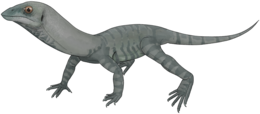| Tanystropheidae Temporal range: Triassic,
| |||
|---|---|---|---|

| |||
| Skeletal reconstruction of Tanystropheus longobardicus | |||

| |||
| Life restoration of Langobardisaurus | |||
| Scientific classification | |||
| Domain: | Eukaryota | ||
| Kingdom: | Animalia | ||
| Phylum: | Chordata | ||
| Class: | Reptilia | ||
| Clade: | Archosauromorpha | ||
| Clade: | †Tanysauria | ||
| Family: | †Tanystropheidae Gervais, 1858 | ||
| Genera[4] | |||
| |||
Tanystropheidae is an extinct family of archosauromorph reptiles that lived throughout the Triassic Period, often considered to be "protorosaurs". They are characterized by their long, stiff necks formed from elongated cervical vertebrae with very long cervical ribs. Members of the group include both terrestrial and aquatic forms. While some tanystropheids were small lizard-like animals, other tanystropheids such as Tanystropheus were large animals that had necks that were several meters long, longer than the rest of their bodies.
Tanystropheids are known from Europe, Asia (Russia, China, and Saudi Arabia), North America[5] and probably South America (Brazil).[6] The presence of tanystropheids in Europe and China indicate that they lived along much of the coastline of the Tethys Ocean.[7] However, species in western North America are found in terrestrial deposits, suggesting that as a group, tanystropheids were ecologically diverse.[5]
Relationships among tanystropheid species have been difficult to resolve because most specimens were flattened during fossilization and are preserved two-dimensionally. Three-dimensional fossils are known from Europe and North America.[5]
- ^ Wang, W.; Spiekman, S. N. F.; Zhao, L.; Rieppel, O.; Scheyer, T. M.; Fraser, N. C.; Li, C. (2023). "A new long-necked archosauromorph from the Guanling Formation (Anisian, Middle Triassic) of southwestern China and its implications for neck evolution in tanystropheids". The Anatomical Record. doi:10.1002/ar.25216. PMID 37029530. S2CID 258028261.
- ^ Lu, Y.-T.; Liu, J. (2023). "A new tanystropheid (Diapsida: Archosauromorpha) from the Middle Triassic of SW China and the biogeographical origin of Tanystropheidae". Journal of Systematic Palaeontology. 21 (1). Bibcode:2023JSPal..2150778L. doi:10.1080/14772019.2023.2250778. S2CID 263634664.
- ^ a b Adam C. Pritchard; Hans-Dieter Sues (2019). "Postcranial remains of Teraterpeton hrynewichorum (Reptilia: Archosauromorpha) and the mosaic evolution of the saurian postcranial skeleton". Journal of Systematic Palaeontology. 17 (20): 1745–1765. Bibcode:2019JSPal..17.1745P. doi:10.1080/14772019.2018.1551249. S2CID 91446492.
- ^ Fossilworks
- ^ a b c Pritchard, Adam C; et al. (2015). "Late Triassic tanystropheids (Reptilia, Archosauromorpha) from northern New Mexico (Petrified Forest Member, Chinle Formation) and the biogeography, functional morphology, and evolution of Tanystropheidae". Journal of Vertebrate Paleontology. 35 (2): e911186. Bibcode:2015JVPal..35E1186P. doi:10.1080/02724634.2014.911186. S2CID 130089407.
- ^ Tiane Macedo De Oliveira; Daniel Oliveira; Cesar L. Schultz; Leonardo Kerber; Felipe L. Pinheiro (2018). "Tanystropheid archosauromorphs in the Lower Triassic of Gondwana". Acta Palaeontologica Polonica. 63 (4): 713–723. doi:10.4202/app.00489.2018.
- ^ Rieppel, O.; Jiang, D. Y.; Fraser, N. C.; Hao, W. C.; Motani, R.; Sun, Y. L.; Sun, Z. Y. (2010). "Tanystropheus cf. T. Longobardicus from the early Late Triassic of Guizhou Province, southwestern China". Journal of Vertebrate Paleontology. 30 (4): 1082. Bibcode:2010JVPal..30.1082R. doi:10.1080/02724634.2010.483548. S2CID 86315078.